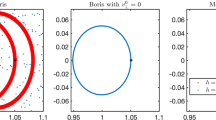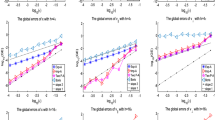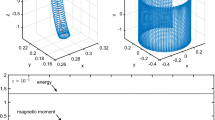Abstract
The Boris algorithm is a widely used numerical integrator for the motion of particles in a magnetic field. This article proves near-conservation of energy over very long times in the special cases where the magnetic field is constant or the electric potential is quadratic. When none of these assumptions is satisfied, it is illustrated by numerical examples that the numerical energy can have a linear drift or its error can behave like a random walk. If the system has a rotational symmetry and the magnetic field is constant, then also the momentum is approximately preserved over very long times, but in a spatially varying magnetic field this is generally not satisfied.


Similar content being viewed by others
References
Boris, J.P.: Relativistic plasma simulation-optimization of a hybrid code. In: Proceeding of Fourth Conference on Numerical Simulations of Plasmas, pp. 3–67 (1970)
Ellison, C.L., Burby, J.W., Qin, H.: Comment on “Symplectic integration of magnetic systems”: a proof that the Boris algorithm is not variational. J. Comput. Phys. 301, 489–493 (2015)
Hairer, E., Lubich, C.: Symmetric multistep methods for charged particle dynamics. SMAI J. Comput. Math. 3, 205–218 (2017)
Hairer, E., Lubich, C., Wanner, G.: Geometric numerical integration illustrated by the Störmer–Verlet method. Acta Numer. 12, 399–450 (2003)
Hairer, E., Lubich, C., Wanner, G.: Geometric Numerical Integration. Structure-Preserving Algorithms for Ordinary Differential Equations. Springer Series in Computational Mathematics, vol. 31, 2nd edn. Springer, Berlin (2006)
Hairer, E., McLachlan, R.I., Skeel, R.D.: On energy conservation of the simplified Takahashi–Imada method. M2AN. Math. Model. Numer. Anal. 43(4), 631–644 (2009)
He, Yang, Zhou, Zhaoqi, Sun, Yajuan, Liu, Jian, Qin, Hong: Explicit \(K\)-symplectic algorithms for charged particle dynamics. Phys. Lett. A 381(6), 568–573 (2017)
Knapp, C., Kendl, A., Koskela, A., Ostermann, A.: Splitting methods for time integration of trajectories in combined electric and magnetic fields. Phys. Rev. E 92, 063310 (2015)
Qin, H., Zhang, S., Xiao, J., Liu, J., Sun, Y., Tang, W.M.: Why is Boris algorithm so good? Phys. Plasmas 20(8), 084503.1–084503.4 (2013)
Tao, M.: Explicit high-order symplectic integrators for charged particles in general electromagnetic fields. J. Comput. Phys. 327, 245–251 (2016)
Zhang, Ruili, Qin, Hong, Tang, Yifa, Liu, Jian, He, Yang, Xiao, Jianyuan: Explicit symplectic algorithms based on generating functions for charged particle dynamics. Phys. Rev. E 94(1), 013205 (2016)
Acknowledgements
We thank our colleague Martin Gander for drawing our attention to the long-time behaviour of the Boris algorithm. The research for this article has been partially supported by the Fonds National Suisse, Project No. 200020_159856.
Author information
Authors and Affiliations
Corresponding author
Additional information
Communicated by Antonella Zanna Munthe-Kaas.
Rights and permissions
About this article
Cite this article
Hairer, E., Lubich, C. Energy behaviour of the Boris method for charged-particle dynamics. Bit Numer Math 58, 969–979 (2018). https://doi.org/10.1007/s10543-018-0713-1
Received:
Accepted:
Published:
Issue Date:
DOI: https://doi.org/10.1007/s10543-018-0713-1
Keywords
- Boris algorithm
- Charged particle
- Magnetic field
- Energy conservation
- Backward error analysis
- Modified differential equation




